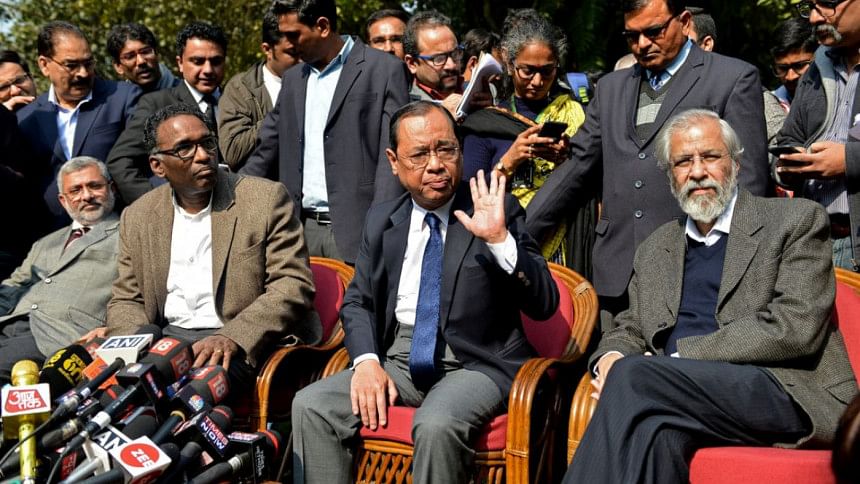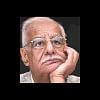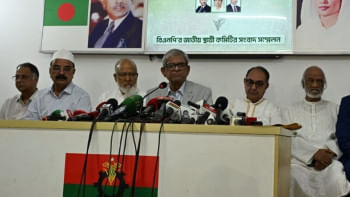Crisis in the Indian judicial system

Whether it was a prover-bial storm in a teacup or something else, the fact remains that the judiciary has been exposed. The impartiality with which it is known has been shaken. For the first time judges face people. This is the best headline which I found in an Urdu daily. It told the story and still left many things unsaid. Four judges of the Supreme Court—Justice J Chelameswar, Ranjan Gogoi, Madan B Lokur and Kurian Joseph—have created history when they held a press conference to tell their side of the story on what Chief of Justice of India Dipak Mishra has been doing. Their contention is that he is only first among equals, northing more or nothing less. But the Chief Justice, they allege, has spread himself all over.
The questioning of the Chief Justice publicly by the four most senior judges of the apex court has put everybody in a fix. But the government has been correct in not interfering and letting the judiciary to settle the matter itself. Understandably, former chief justices have also expressed their "shock" over the unprecedented press conference by the four judges.
In his reaction, former chief justice RM Lodha has questioned how such a boiling issue had remained pending for two months. "I am disturbed by today's development. What happened today is unfortunate and painful for a person who presided over an institution like the Supreme Court." Reacting to the letter made public, the former chief justice is right when he says that the chief justice ought to have discussed it with them and addressed those issues.
The issues, as pointed out by the four judges, may not be big. But they need to be addressed because both the chief justice of India and Justice J Chelameswar, the second senior most, have been at loggerheads after the latter assigned a petition which sought probe into the medical college scam—former Odisha High Court judge IM Quddusi was suspected to be involved in it—to a bench of top five judges. But this decision was overturned by a five-judge Constitution bench which ruled that the CJI was the master of roster and he alone could assign cases to different benches.
Even otherwise, in recent times the bench formation in the Supreme Court has been against the text of the Constitution which is very clear on constitutional issues because such matters have to be heard by a five-judge bench. But what has happened in recent times is that they have been referred to two- or three-judge benches. This has not only eroded the confidence of fellow judges of the highest court in the land but has, as a result, created a crisis-like situation.
Differences among judges are nothing new. There have been past instances where judges of the apex court have fought over certain issues. The tussles between Justice YV Chandrachud and his successor Justice PN Bhagwati in the 1970s and 1980s or the one between Justice AM Ahmadi and Justice Kuldip Singh in the 1990s were considered examples of "indiscipline" rather than "rebellion."
Whatever may be the differences, the press conference by the sitting judges has definitely irretrievably dented the integrity of the institution and also the moral authority of the Supreme Court. In the letter addressed to the CJI, the four judges have rightly pleaded with him to take corrective measures so that they can apprise him about similar judicial orders that need to be dealt with by him.
In our legal system, based on rule-of-law, no one including the Chief Justice is above it. No doubt, the CJI has the powers to form benches but the powers are supposed to be exercised judiciously and not arbitrarily. The government is looking for a window of opportunity to enforce the National Judicial Appointment Commission Act which the judges have rejected. Unfortunately, the judges have not realised that they have already provided that by the current row which the government may use to have greater say in judicial appointments and transfers.
India is fortunate to have independent judiciary since freedom. But two judges, HR Khanna of the Supreme Court and Jagmohanlal Sinha of Allahabad High Court, raised it to great heights at a time when the judiciary was timid and when it was a fashion to feather one's own nest. Khanna, during the emergency, spoke the truth knowing well the consequences he would face. He differed with his other four colleagues and upheld the inviolability of fundamental rights. He was superseded and he resigned in protest.
With Justice Ranjan Gogoi next in line to succeed Justice Dipak Misra as CJI when the latter retires in October this year, he may face a situation similar to the one that Justice Khanna faced many years ago. But the latter's judgment gave hope to the people of India that there were judges to uphold the truth even when the tallest in the country had compromised to stay in office. Khanna told the nation that the fundamental values of a democratic society demanded that every person must display a degree of vigilance and willingness to sacrifice. This is still a distant goal for India.
Despite such examples, the judiciary is losing sheen. People's faith in obtaining justice is weakening, not only due to inordinate delays in getting the cases heard but also due to the increasing impression that the judges can be managed. Clients and lawyers reportedly conspire to have hearings fixed before a particular judge. The word, corruption, was not heard some years ago. Today, it is on everybody's lip.
Not long ago, judgments were pro-people, pro-weak and pro-environment. Laws were interpreted in such a manner that a common man got relief and the greenery was protected against the marauding builders. The judiciary, particularly after globalisation, has tended to side with the rich, powerful and those who destroy the flora and fauna. The judiciary has also tried to arrogate itself the authority which belongs to the legislatures.
The judiciary has become a very important segment of public life. Politicians can be disciplined only through the law. If the Supreme Court judges think about themselves and not the law, democracy can be in danger.
Kuldip Nayar is an eminent Indian columnist.






Comments